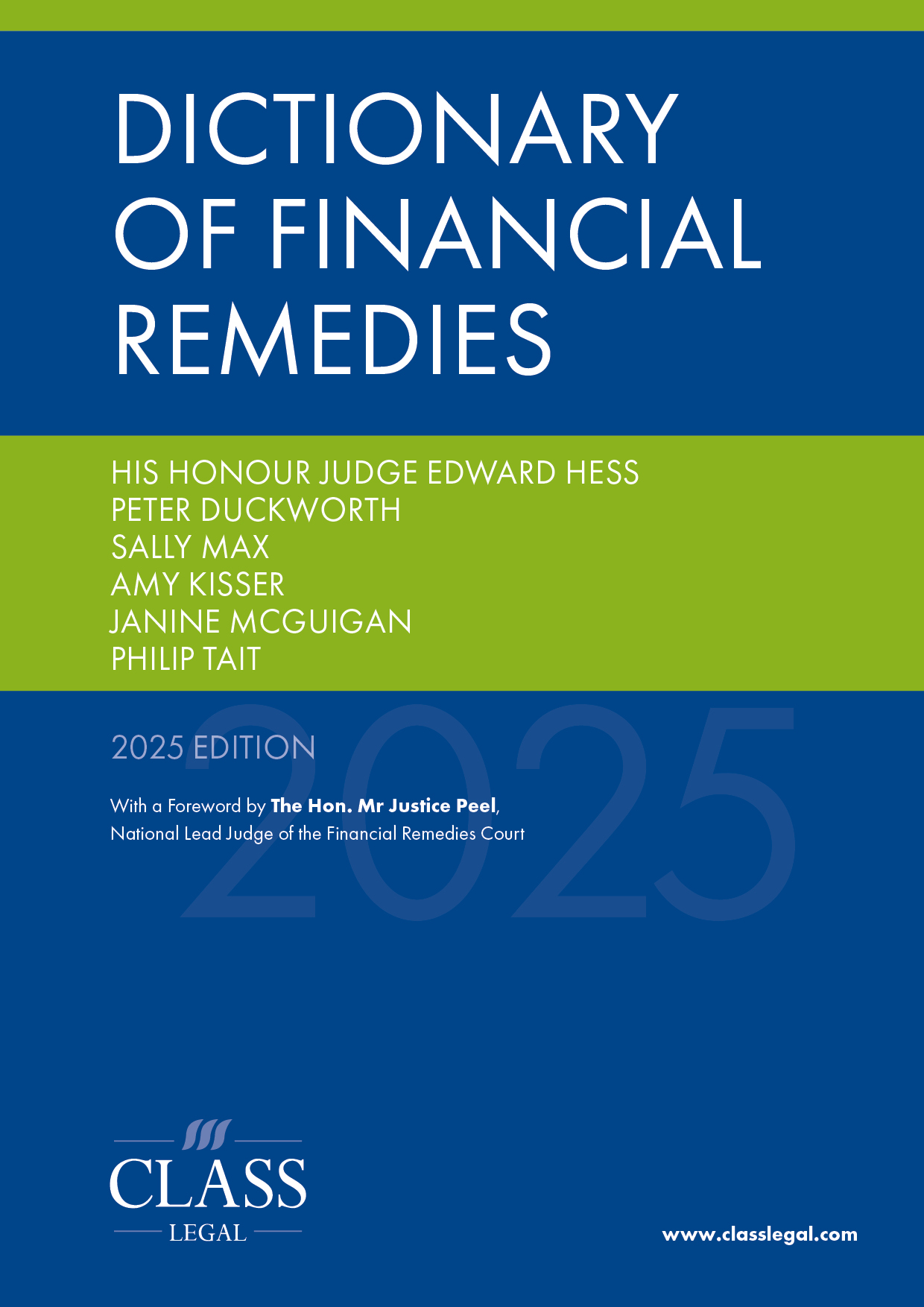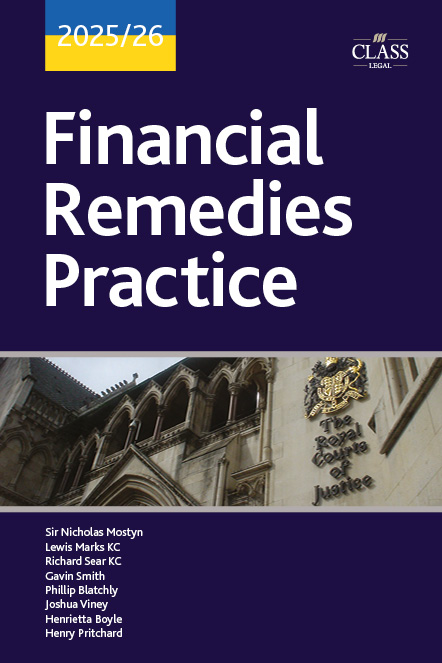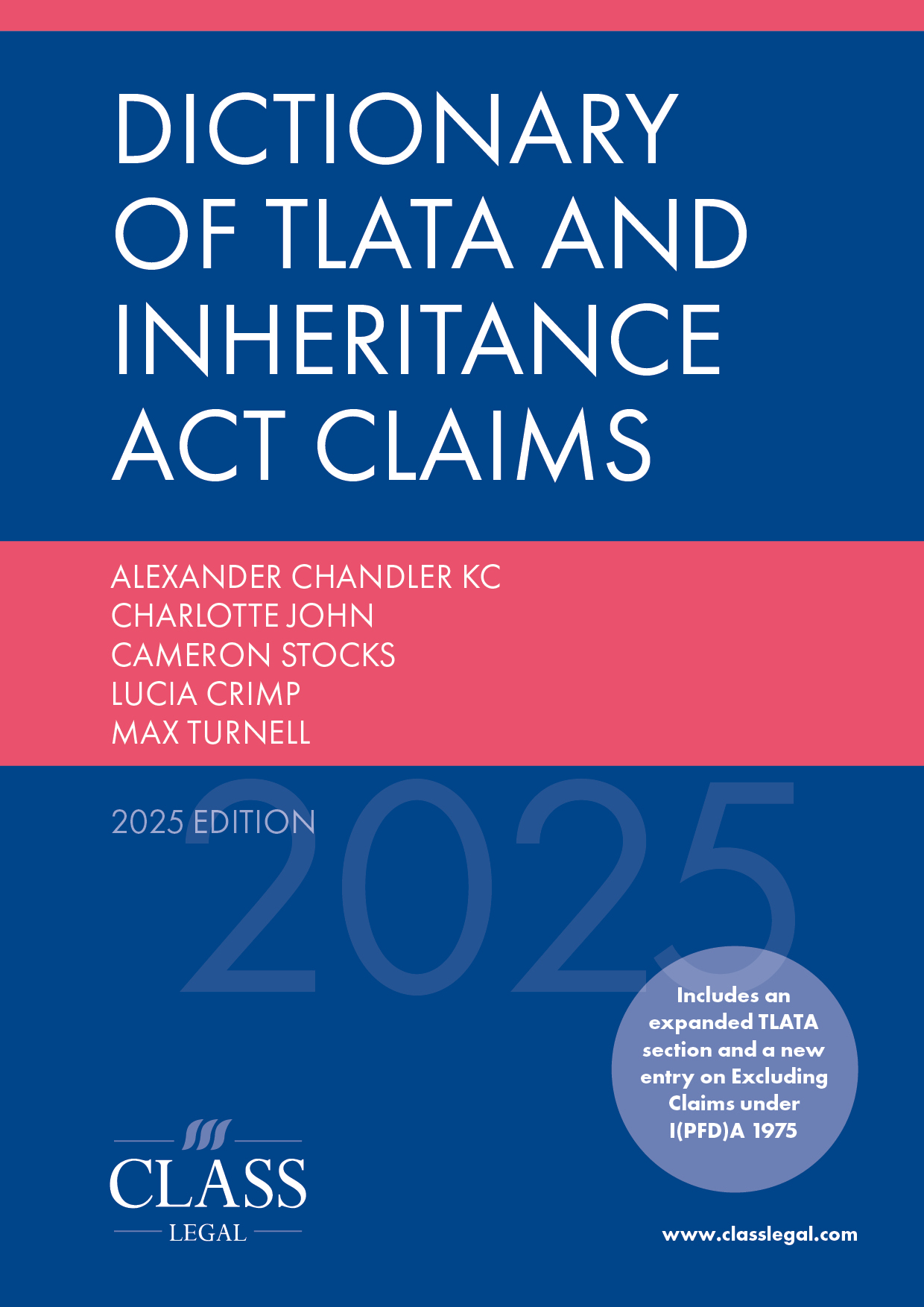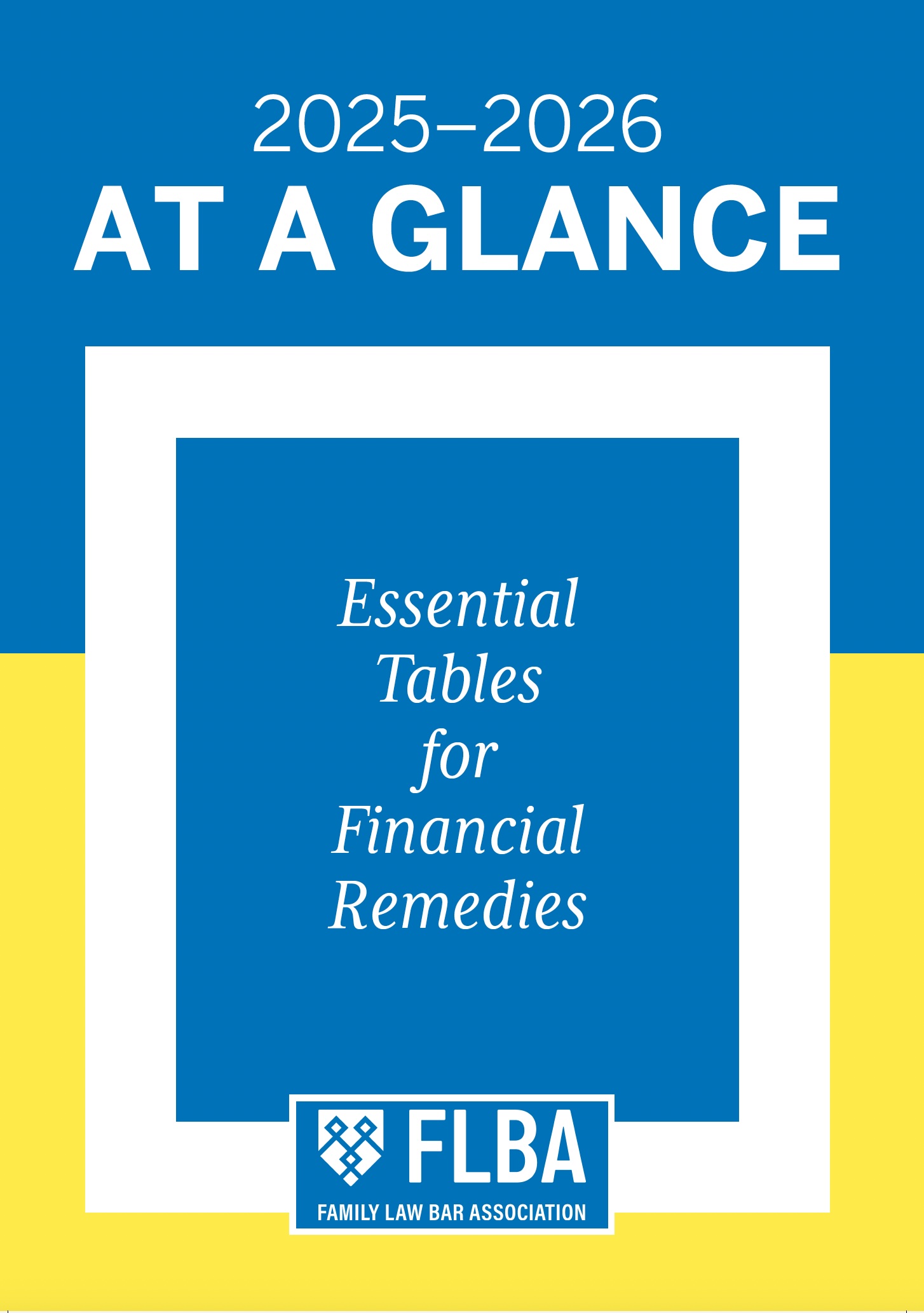
Flo, FI v DO and the Future: Dogs on Divorce
Published: 30/06/2025 06:00

Flo
Meet Flo. She is my Cavalier King Charles Spaniel. I know I am biased, but she is beautiful and is a key member of my family. I bought her with my very first pay cheque from my work as a barrister and she has been with me ever since. She is my trusty companion.
In the days of twitter, Flo would regularly feature alongside short summaries of recent family law cases. She would always attract more ‘likes’ and ‘retweets’ compared to the reported cases on which I would comment! Flo has appeared in the Law Paw Charity Calendar for Billable Hour, complete with my wig and gown. She is a regular member of Sunday Homework club, although her contribution is often of the snoring kind. And who can forget remote hearings through COVID-19 lockdowns, as despite a long morning walk and a tonne of treats before the hearing started, there was often a distant bark or whimper mid-hearing coming from downstairs. She is sitting at my feet as I pen this piece. I know I am not alone in sharing how special Flo is to me. Friends, colleagues and contacts in the legal world often talk to me about their pets, whether that be a pooch, a pet of the feline variety or another beloved animal.
So, why bleat on about Flo? Well, at present, the financial remedies world is talking a lot about pets on divorce. One only need consider the recently reported case of FI v DO [2024] EWFC 384 (B), peruse LinkedIn to see articles about so-called ‘pet nups’, or consider the material generated by the Pets on Divorce Working Group to appreciate the point. Pets are often regarded as treasured members of the family and are sentient beings, and what happens to our beloved pets on divorce is a hot topic.
Current law
So, what’s the current state of the law?
The law is trite. Pursuant to s 24 Matrimonial Causes Act 1973 the court is able to make property adjustment orders, which includes orders against not only bricks and mortar, but also chattels and personal property.
Put simply, Flo is a chattel.
If I was to divorce, the Financial Remedies Court (FRC), or an Arbitrator, could make an order in relation to Flo. Of course the tribunal’s job would be to achieve an outcome which is ‘as fair as possible in all the circumstances’, per Lord Nicholls at 983H in White v White [2000] UKHL 54, [2000] 2 FLR 981, but I am almost certain that if the order provided for me to retain Flo, her co-owner would regard that as totally unfair, as I certainly would if the order was the other way around.
So, how does the court exercise its discretion when dealing with chattels and personal property? This question has already been tackled by Nicholas Allen KC (who beat me to it) in his erudite blog post ‘Chattels: What If They Are Not to Be Divided by Agreement?’1 published on 28 April 2025 on the FRJ Blog. Although I could never do justice to Nick’s piece, which I urge readers to consider in full, the main points can be distilled as follows:
(1) There exists some guidance as to the appropriate mechanism when dealing with division of chattels.
(2) One such case is K v K (Ancillary Relief: Property Division) [2005] EWHC 1070 (Fam), [2005] 2 FLR 1137, a decision of Baron J, in which Her Ladyship said, ‘in my experience, the division of chattels can often be problematic, particularly where items of sentimental value are concerned’. The parties in K v K owned £330,000 of valuable antiques in relation to which no steps had been taken to resolve, or even narrow, who was going to keep what prior to the commencement of the trial. After observing the costs of the litigation thus far, Her Ladyship did not relish the prospect that there might have to be another round of litigation dealing with chattels, saying such would be ‘unacceptable’. The caution:
‘Solicitors must not forget chattels. As a matter of practice, the division of chattels must be accomplished prior to trial (with a clear schedule denoting the destination of items). If the parties cannot agree, then a Scott schedule must be completed with the items marked as agreed or remaining in dispute. The schedule should set out, in very short form, the reasons why any particular item is sought.’
At the court’s direction, the parties drew up a schedule and agreed a mechanism to resolve the issue.
(3) Rayden & Jackson on Relationship Breakdown, Finances and Children refers only to K v K as giving guidance on dealing with valuable chattels. This is not perhaps surprising given the paucity of authority on the point.
(4) There is even less authority on how the jurisdiction should be exercised.
(5) Proportionality must not be forgotten. In B v B [2013] EWHC 1232 (Fam), by all accounts a big money case, Coleridge J said:
‘[54] Although the parties are to be applauded for achieving agreement on many of the major issues and certainly cannot be criticised for the disagreement over the apportionment of the [MB] funds, a mild rebuke is justified over their approach to the lesser assets. The small differences (as a proportion of the pot) in the value of the yacht, the approach to cars, the credit cards etc, etc does not merit the time (and costs) spent on them. As the rules now make clear, proportionality is the name of the game when costs are so high and court time is more and more at a premium. A much more rigorous approach to case management (especially in the field of the employment of experts) is being introduced in other areas of the family justice system to save precious time and money. This type of high value litigation cannot expect to be immune and parties to it can expect to be confronted more and more by a refusal by the court to participate in these disputes over the lesser assets and where in each case the difference is around 1% of the net value of the pot or less. Assets falling in this category should be bundled up together and an overall value for them all agreed. If not the court is itself likely to apply that system in a broad, even rough and ready, way. As Mr Marks QC observes the pursuit of precise accuracy is a spurious and vain endeavour where the figures are in most cases derived from professional valuations and opinion and assets are not being sold anyway.
[55] Paragraph 54 above has been seen and approved by the President.’
(6) Whilst a ‘chattels’ claim is not brought under s 188 Law of Property Act 1925, the breadth of the discretion therein is wide:
‘Where any chattels belong to persons in undivided shares, the persons interested in a moiety (i.e. one of two parts) or upwards may apply to the court for an order for the division of the chattels or any of them, according to a valuation or otherwise and the court may make such order and give any consequential directions as it thinks fit.’
(7) Moylan J (as he then was) in RK v RK (Financial Resources: Trust Assets) [2011] EWHC 3910 (Fam), [2013] 1 FLR 329, said:
‘[89] It is not unusual for chattels which have been purchased during the course of a marriage with funds provided by a relative or by way of inheritance to be divided between the parties as part of a fair division of the former matrimonial home’s chattels …’
The main chattels dispute concerned a painting purchased using part of an inheritance from the husband’s family. However, I will drop a marker here and return to it below, as RK v RK also concerned a dispute about the family dogs.
(8) Other authorities touching on the topic, but at the same time not really providing any general guidance, include:
(a) Re C (Divorce: Financial Relief) [2007] EWHC 1911 (Fam), [2008] 1 FLR 625, another Baron J decision this time concerning an aeroplane valued at £120,000;
(b) Joy v Joy [2015] EWHC 455 (Fam), a decision of Singer J, pertaining to an application to secure a Bentley motor vehicle so as to satisfy other orders;
(c) G v T [2020] EWHC 1613 (Fam) in which Nicholas Cusworth QC (sitting as a deputy High Court Judge) excluded from the asset schedule contents and artwork finding that an in specie division could be discussed and arranged, including as their value was de minimis in the context of the case and the issues in dispute; and
(d) KFK v DQD [2024] EWFC 78 (B) in which Recorder Rhys Taylor, in the context of both parties seeking to retain the contents of Flatacre, said:
‘260. … the overriding objective includes the requirement to allot an appropriate share of the court’s resources to the dispute, whilst taking into account the need to allot resources to other cases. This case has now had its fair share of judicial time.’
Recorder Rhys Taylor gave the parties 28 days to resolve the issue of division with liberty to restore within 35 days before him, at the same time expressly reserving the option of the items being sold on eBay or the like, with the parties each being free to bid for items or to enjoy a 50/50 division of whatever net sum is produced from the sale.
Nick drew the threads together as follows:
‘What may perhaps be taken from foregoing (in no particular order) is:
1. As the court is making a property adjustment order under MCA 1973, s 24(1)(a), it must apply s 25. It is therefore the court’s duty to have regard to all the circumstances of the case giving first consideration to the welfare of any child or children of the family who is under 18. The court must have particular regard to the matters set out in s 25(2).
2. The court’s objective is to achieve fairness (White v White [2000] 2 FLR 981 per Lord Nicholls of Birkenhead). It goes without saying that this involves fairness to both parties. There is no place for discrimination between husband and wife.
3. The authorities (such as they are) mainly focus on the mechanics of division rather than the principles of division.
4. Parties may agree that chattels are to be divided by value and/or number (but may also not so agree).
5. Parties may base their claim on little more than “I want that chattel because …” – i.e. no legal/beneficial entitlement needs to be evidenced.
6. It is not unusual for chattels purchased during a marriage with non-marital monies to be divided between the parties as part of a fair division.
7. From a court’s perspective – where it is required to give effect to the overriding objective (and which includes at r 1.2(b) “dealing with the case in ways which are proportionate to the nature, importance and complexity of the issues”; (d) “saving expense”; and (e) “allotting to it an appropriate share of the court’s resources, while taking into account the need to allot resources to other cases”) – proportionality is key and the court’s approach to division may be a broad and potentially robust/simplistic one.
8. The overriding objective does not apply to arbitration proceedings in the same way particularly as parties may choose to arbitrate what they wish at their joint cost (subject to any order for costs that may be made) and r 1.2(e) does not apply in the same way. However, this does not mean that an arbitrator ought not take a proportionate approach to issues such as these not least because Coleridge J’s observation in B v B at [54] that “the pursuit of precise accuracy is a spurious and vain endeavour where the figures are in most cases derived from professional valuations and opinion and assets are not being sold anyway” is of general application.’
But what about Flo? Flo isn’t an antique, although she is now more mature. She isn’t a Bentley. She isn’t the photograph which hangs above the hearth purchased with inherited funds. Flo is a dog, and part of my family. Should she be treated by the court in the same way as other chattels on divorce?
Pet nups
One option for parties to deal with the potential fall out as to the fate of a family pet on divorce is to make an agreement ahead of time. As we know from Radmacher v Granatino [2010] UKSC 42 ‘the court should give effect to a nuptial agreement that is freely entered into by each party with a full appreciation of its implications unless in the circumstances prevailing it would not be fair to hold the parties to their agreement’. Absent successful challenge to a nuptial agreement, the terms, in most cases, prevail. With sufficient foresight, a nuptial agreement could cover what is to happen to a pet on separation, after all, a pet is a chattel.
A simple perusal of the web throws up ample articles on so-called ‘pet nups’, with considerations including ownership and ‘custody’, financial responsibilities, contact with the non-resident party, and what happens to the dog if the owner dies or moves. In my own practice at least two nuptial agreements have included clauses about pets.
But what about those cases where there is no ‘pet-nup’? What does the court do? There is a scarcity of authority expressly dealing with family pets.
FI v DO [2024] EWFC 384 (B)
The decision with which most readers will be familiar is FI v DO [2024] EWFC 384 (B).
FI v DO is the first instance decision of District Judge Crisp, who was dealing with a financial remedies claim following a 12-year marriage. The parties had two children, who at the time of the hearing lived with their mother, having no contact with their father. Then there was, N, the family dog, in relation to whom the husband had issued an application seeking a declaration of ownership and a shared care arrangement. Initially the wife sought to keep N in her care but with periods of contact between N and the husband, however following an incident in December 2022 (referred to in the judgment as an alleged abduction) her position changed such that she no longer supported any contact. District Judge Crisp, who described the dispute concerning N as the ‘thorny issue’ between the parties, had the task of determining N’s fate.
On the one hand the husband argued that he purchased N, with the wife making no financial contribution thereto. He claimed N was trained by him and that she was registered as his disability support dog, in support of which he produced a letter from his medical practitioner. N was required, on the husband’s case, to assist him with his anxiety and depression. The wife had not looked after N post-separation, including a failure to feed and walk her, so said the husband, who, overall, asserted that he had become N’s sole carer.
On the other hand, the wife claimed the parties jointly purchased N, following the loss of their former dog which caused much upset for the children, with their daughter using £320 of her birthday money, the wife contributing £280, and the husband paying the balance of £600. The wife pointed out that she was N’s registered keeper, had registered N at the Kennel Club and paid for all N’s upkeep. The wife also disputed that N was ever registered as a disability support dog in the currency of the parties’ relationship.
As to the alleged abduction, the wife accused the husband of taking N, with force, from her own mother whilst she was walking N. The police were called, and the husband was reported to the RSPCA. N returned with damaged paws from being dragged. The husband’s account differed. He claimed N was running freely, that he took her and she was happy to go with him. When cross-examined, the husband explained he had been exercising his legal rights and compared his superior rights over the rights of the wife’s mother. The husband however accepted N had run back to the family home, where the wife was living, and that he had followed. He denied dragging N.
Having read and heard the evidence, in relation to N, District Judge Crisp found:
(1) N’s registration as a support dog first occurred in February 2024. If N had been registered as a support dog before this point, it would have been easy to go onto the internet to obtain a copy of previous registrations. Fortified in this conclusion, District Judge Crisp noted that the husband’s earlier civil claim and letter before action, written in January 2024, did not ask for return of N because she is a support dog but rather that the husband wished N to be delivered up, or a shared care arrangement implemented, together with a money claim of £39,600 for the loss of litters during N’s lifetime. The husband registered N as a disability support animal to support his claim in the financial remedy proceedings that she should be returned to him.
(2) Although irrelevant to the issues in the case, the parties jointly purchased N.
(3) The wife’s evidence was compelling when she said ‘I would not force a dog to come away when he didn’t know me’ when talking about the alleged abduction. The wife has lived with dogs all her life and they are an integral part of her and the children’s lives.
(4) The husband has no inclination as to the upset that will have been caused to the wife’s mother, the wife and the children when he forcibly removed N from the grandmother outside the family home.
(5) The children see N as their dog.
(6) The husband fails to see the implications of his action on the family and on N.
(7) As to the allegation the wife did not care for N post-separation, the wife’s evidence was far more in tune with someone who has the welfare of N at heart.
District Judge Crisp was referred to the decision of RK v RK in which Moylan J (as he then was) said this concerning the dog:
‘85. There are a few subsidiary issues I must determine, including the wife’s claim to a painting and to one of the family dogs. On the latter issue, I do not consider it appropriate to make any order in respect of one of the dogs because, on the evidence I have heard, they would seem to have been looked after principally by the husband.’
So, how did District Judge Crisp approach the dispute concerning N?
She observed:
‘The legal authority to which I have referred provides assistance as to who has principally looked after the dog. Not who has purchased the dog, that fact in my view is not as important as who the dog sees as her carer. This is not who had previously looked after the dog, but who does now. It is an agreed fact that the parties separated and the dog has been cared for solely by the wife since that separation some 18 months previously. I accept what the wife says 18 months is a long time in a dog’s life. It was clear when the dog ran back to the family home after he had been taken by the husband that the dog considered that to be a safe place and where he belonged. The wife’s evidence as I have set out was compelling but more importantly in my view showed someone who understood about dogs, was compassionate and would always put the dog’s interests first. The dog’s home is with the wife, and she should stay there. It would be upsetting for both the dog and the children were those arrangements to alter. The husband has managed without a dog for 18 months and it does not therefore seem necessary for his support, even if that were the case which I do not accept was the position at the time the parties separated.’
As you may have guessed, District Judge Crisp ordered that the wife retain ownership of N.
The excerpt above succinctly summarises why, for District Judge Crisp, N was to remain with the wife. The care of N post-separation was relevant, as was the wife’s demonstrable understanding about and compassion towards dogs, coupled with the importance of N to the children of the marriage who lived with their mother. These considerations simply do not crop up if the issue is, for example: Who gets the living room coffee table?
FI v DO generated a lot of attention. Readers of the FRJ Blog will perhaps recall the blog post ‘On Dogs and Divorce’2 by District Judge Hatvany published on 21 January 2025. Readers of the Blog met District Judge Hatvany’s treasured companion, Ernest, the English bull terrier, and were treated to a photo of him reclining on a chaise longue doing his best Kate Winslet impression à la Titanic. District Judge Hatvany postulated: How can Ernest have the same legal status as a settee? He went on:
‘Our legal system has a reputation for being the finest on the planet. Yet in court, the legal test for who gets to keep the family dog is the same as that for any other inanimate content of the family home.’
The post ends with a plea (and a poem):
‘In a legal system that prides itself on fairness and humanity, treating pets as chattels is both a relic and a betrayal. Has the time not come for the law to recognise the reality that animals are neither property nor mere ornaments in our lives? They are, like Ernest, our companions, confidants, and occasionally our greatest source of chaos and amusement.
“So here’s my plea for a legal shakeup
treat pets like family, not just a breakup
for Ernest’s no chair no trinket no tat
he’s priceless, and frankly he’d agree with that!”’
Following the President of the Family Division’s recent guidance on ‘Citation of Authorities: Judgments of Circuit Judges and District Judges’,3 published on 24 February 2025, read alongside the approved list of judgments in cases below High Court level4 which have been retrospectively certified as suitable for citation pursuant to the said Guidance, FI v DO is not a citable authority. It nevertheless gives us an insight into how District Judge Crisp dealt with the issue in the case before her. RK v RK, to which District Judge Crisp refers in FI v DO, is of course a citable case, being a High Court decision, and whilst the dog in that case is dealt with in one line, that one line does refer to the husband having cared for the dogs after separation.
What if Flo was a snow dog or a beach dog?
If Flo lived with me in a beautiful chalet in Whistler, British Columbia (albeit she doesn’t like the snow), and I were to divorce, how would the court deal with Flo? Is the law as it is here? In short, no.
Whilst I am not a Canadian family lawyer, I understand5 that following changes to British Columbia’s Family Law Act, which came into force in January 2024, a ‘companion animal’, defined by s 1 as ‘an animal that is kept primarily for companionship’,6 is treated differently to other property when it comes to decisions about possession and ownership. Pursuant to s 927 separating or divorcing spouses can make their own agreement about the possession and ownership of a companion animal, which may include jointly owning a companion animal, sharing possession of a companion animal, or giving exclusive ownership or possession of a companion animal to one of the spouses. If, however, agreement is not possible, s 977 permits a spouse to ask the court to decide who will have possession and ownership of a companion animal. The factors for consideration include: (1) the circumstances in which the companion animal was acquired; (2) the extent to which each spouse cared for the companion animal; (3) any history of family violence; (4) the risk of family violence; (5) any cruelty or threat of cruelty toward the animal by either spouse; (6) the relationship between a child and the companion animal; (7) the willingness and ability of each spouse to meet the basic needs of the companion animal; and (8) any other circumstances the court deems relevant. There are some limitations, in that the court can only make an order for ownership and possession of a companion animal by one spouse. The court cannot declare that spouses jointly own the companion animal or require spouses to share possession of the companion animal. The criteria are however clear, and they provide a guide for the judiciary where the fate of a companion animal requires adjudication.
As of April 2025, is has been reported in the Canadian press9 that, for the first time since the recent changes to the Family Law Act, a judge has awarded custody of a family pet in a divorce. Justice Maegen M Giltrow made an order that Toba, a beloved pet dog, should remain in the care of the wife following the divorce proceedings. The judge emphasised that whilst pets are still regarded as personal property, under the new laws the court has discretion to consider who is most equipped and best suited to care for the pet, and on the facts that was the wife. It is clearly recognition of the importance of pets as sentient beings.
Let’s hop on a plane. What if I decided to relocate to the Gold Coast in Brisbane and bring Flo with me (she does love the beach). If I were to divorce, what would happen to Flo?
Well, very shortly, hot on the heels of British Columbia, Flo might well be treated by the court in the same way as she would in Whistler. By the time of publication of this piece, legislative amendments10 very similar to those in British Columbia will have come into effect (as of June 2025). The criteria for consideration are as follows: (1) the circumstances in which the companion animal was acquired; (2) who has ownership or possession of the companion animal; (3) the extent to which each party cared for, and paid for the maintenance of, the companion animal; (4) any family violence to which one party has subjected or exposed the other party; (5) any history of actual or threatened cruelty or abuse by a party towards the companion animal; (6) any attachment by a party, or a child of the marriage, to the companion animal; (7) the demonstrated ability of each party to care for and maintain the companion animal in the future, without support or involvement from the other party; (8) any other fact or circumstance which, in the opinion of the court, the justice of the case requires to be taken into account.
I could continue to globe trot (Flo is always up for an adventure) as there are other examples from other jurisdictions as to the different treatment of pets on divorce as compared to the jurisdiction of England and Wales. However, not being greedy and being satisfied with a snow and a beach break, looking at the framework in two commonwealth countries, Canada and Australia, demonstrates how differently pets are treated when their owners divorce. Specific legislation requires the court to consider a list of careful criteria to ensure that the best decision is made for the animal concerned.
The future?
Alongside the international financial remedy practitioners who might be thinking about a forum conveniens argument (which is outwith this piece), if I were to move to Canada or Australia, the devil’s advocates amongst you may pose the question: ‘Is there any reason why some, or all, of the above factors couldn’t be considered by the FRC absent specific legislation on the point?’ District Judge Crisp certainly considered several of the factors in FI v DO. But does the hope of litigating this very issue before a judge who is prepared to engage with some, or all, of the above factors offer sufficient protection for beloved pets on divorce? Some, and probably many, would say ‘no’.
Many readers (especially the animal lovers amongst you) will likely be familiar with the ‘Pets on Divorce Working Group’ (the Working Group). Spearheaded by Estella Newbold-Brown, Head of Family Law at Amphlett Lissimore, and Sarah Lucy Cooper of Thomas More Chambers, the Working Group comprises a set of professionals spanning the legal profession (and beyond) who are dedicated to bring about legislative change to ensure pets are treated differently to other chattels on divorce. The Working Group has a LinkedIn page which contains a raft of information about its aims and progress. I can vouch for the cute photos of the members’ pets.
Sarah Lucy Cooper, one of the co-founders, recently noted that:
‘the whole of the UK is sadly becoming an outlier as the examples [the Working Group] have collated from many other jurisdictions clearly show. Australia, Argentina, Colombia, Spain, Portugal, France, Italy, New Zealand, many states of the USA, and many states of Canada are just some of the jurisdictions where domesticated animals have a different status to other chattels on divorce.’11
Moving forward, I understand that there is a forthcoming short survey to be circulated by Resolution, the Family Law Bar Association and the Scottish Family Law Association on behalf of the Working Group designed to understand how common pet disputes are. The issue is also drawing traction in the wider media with members of the Working Group appearing on local and national radio shows.
Supporters of the Working Group have also been encouraged to contact their MPs, and the issue has already reached the House of Lords. In February 2025, Baroness Berridge, during the debate on Prenuptial Agreements,12 highlighted the issue. The Baroness began by noting that:
‘there are currently about 13 million dogs and about 10 million cats as pets, so it is actually not a minority issue. The United Kingdom is becoming something of an outlier legally in relation to this. I am sure the noble Lord, Lord Meston, from his role at the International Academy of Family Lawyers, will be aware of this as well. The recent decision of District Judge Crisp in FI v DO on 20 December last year in the Manchester family court outlined what might become a test for other cases to decide, as in that case, who gets custody of the dog.’
The speech continued by acknowledging that a change in the law could avoid some litigation, or at least that is what she hoped.
Baroness Berridge then referred to District Judge Hatvany’s blog post, and in so doing noted that the ‘niche professional journal got a large response to this blog piece on pets’. As Blog Editor, I can confirm it did indeed. Noting that change has happened, or is happening, in other jurisdictions, the following examples were referenced: (1) Colombia amended its law in 2016 and its case-law recognises that emotional bonds to animals within families do not equate to making animals equivalent to humans; (2) proposals are apparently afoot to amend the Italian legal code to ‘regulate the custody of family pets upon separation or divorce’; and (3) New York has a best interests test on deciding the custody of a companion animal.
Towards the conclusion of her speech, the Baroness posed the following questions: ‘Do His Majesty’s Government have a view on pets in prenuptial agreements and on whether they should continue to be considered chattels? Is the committee that your Lordships established under the Animal Welfare (Sentience) Act 2022 looking at this matter?’
Sir Nicholas Mostyn, former High Court Judge (and a fellow Swiftie), has shared his wisdom on the topic too:11
‘As a retired High Court Family Division judge and the co-owner of a beloved miniature dachshund, I am well able to understand the additional stresses that disputes about pets can cause on divorce. Pets should not be treated by the Courts merely as another chattel, equivalent to the family car or a grandfather clock, as Baroness Berridge rightly argued in the House of Lords on 27 February 2025. Pet owners know that pet welfare demands a different approach. I commend this project to bring about a much needed change. This is a huge step forward for the Pets on Divorce working group.’
Who could disagree with Sir Nicholas?
Flo is my sidekick. If ever I found myself in dispute over Flo, the lawyer in me would say, let’s sit around a table and be sensible about this, failing which let’s arbitrate the issue, having FPR Part 3 in mind. But if agreement was not possible, as things stand, if there had to be a determination of Flo’s fate, the outcome would be uncertain and there is no guarantee that factors relevant to her welfare would be considered by the court. Would the court even engage with the issue? Would my and her co-owner’s skills at caring for Flo be poured over by the court? Would the fact I bought her carry any weight, even if not decisive? Would she be treated as just any other chattel?
For now, we await what may come, especially with the determination and enthusiasm of the Working Group at the fore. Watch this space.
Postscript: Having shared a draft of this piece with Flo’s co-owner, he suggested the answer is simple: put Flo in the centre of the room with one of us to her left, and the other to her right, and allow her to pick. As much as she is my little shadow, I hate to admit it, but his confidence that she would choose him is probably not misplaced!












